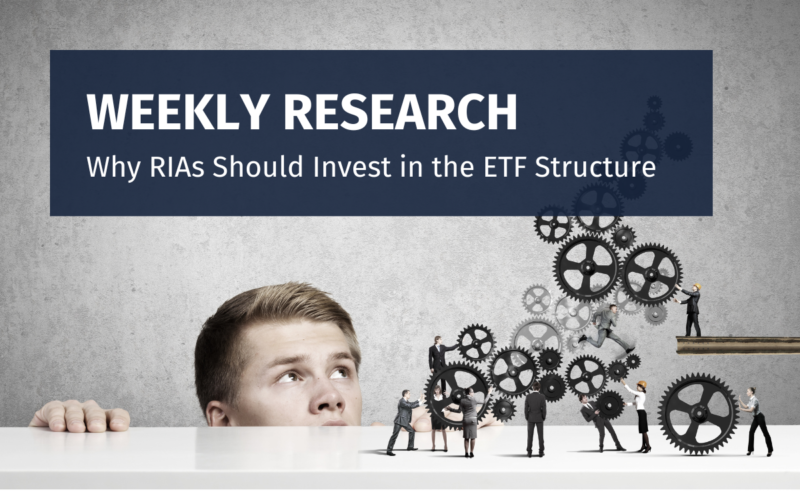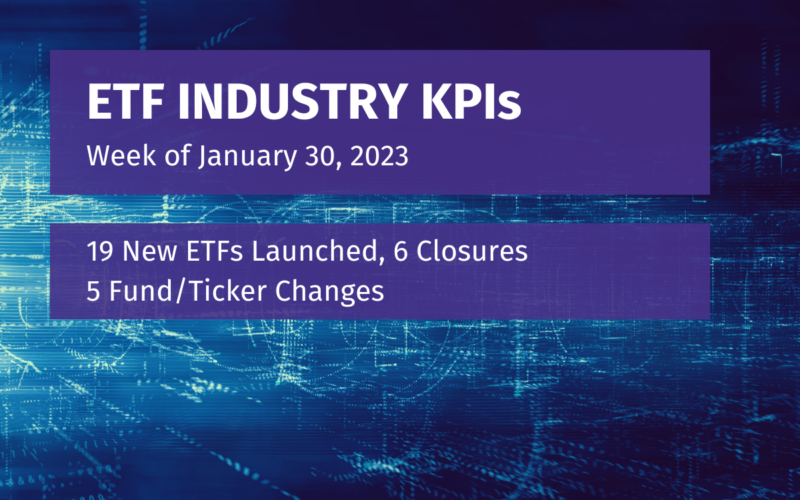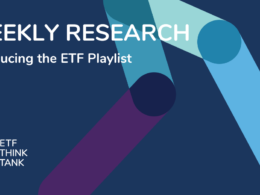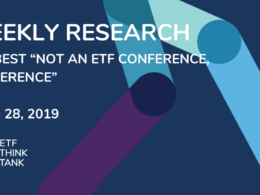Many advisors are evaluating whether converting a separately managed account (SMA) into an ETF makes sense for their taxable clients. The answer is almost always “yes.” But few advisors seem to fully consider the ancillary benefits ETFs bring to their businesses.

Launching an ETF today – through a conversion or otherwise – is much easier and cheaper to do than it was just a decade ago thanks to a simpler regulatory framework, new white label solutions, and an ETF ecosystem that has had 30 years to improve on its processes and technology.
But launching an ETF is not only a big undertaking. It’s an investment on the part of the provider, which is why it is important to take a closer look at the cost-benefit of the effort and understand the pros and cons to both clients and advisors.
We’ve recently done some work on the reasons why launch an ETF and what makes an ETF successful. Today, we dive into the details of a SMA to ETF conversion.
We’ve talked to some advisors who’ve done it, and perhaps the best place to start this process is by asking yourself, why? Why consider a SMA to ETF conversion?
In the words of one advisor, who did a conversion almost three years ago and whose ETF today has more than $1 billion in assets under management, here’s why:
“The bottom line is we thought this process created a more efficient market exposure for our clients. That’s why we did it.”
So, let’s break this process down by addressing a few key questions.
What are the benefits of converting a SMA into an ETF?
a. Tax Efficiency
There’s a fiduciary benefit to an end client by offering an ETF instead of an SMA: tax efficiency. An ETF is a more tax efficient investment product than a SMA or a mutual fund.
Thanks to their unique creation/redemption mechanism, ETFs are able to intentionally manage the cost basis of their portfolios, washing out capital gains overtime through the use of custom baskets. This isn’t trickery or any sort of tax dodging scheme – it’s a virtue of the in-kind creation/redemption mechanism unique to ETFs.
For the advisor, ETFs offer the added benefit of tax management simplicity vs that of a SMA. Taxes are complicated. Managing taxes on individual securities and multiple portfolio positions across a large number of individual SMAs is time consuming. ETFs simplify that task.
In the event of a conversion, there may be an immediate tax consideration for clients if someone is looking to exit the position. Once a new ETF is created, as a new investment company, it may impact long-term vs. short-term tax rates for existing clients in the original SMA undergoing the conversion. Always consult a tax professional and communicate with clients openly.
b. Fee Insulation
Put simply, clients may be able to write off their ETF fee, as a tax deduction, whereas they may not do so with a SMA. Consider this example:
Imagine a client has $1 million invested in 10 ETFs ($100,000 in each) within a SMA, which the advisor charges a 1% advisory fee. The client is unable to claim that advisory fee as a tax deduction, they can’t write off that expense. Now, if the advisor creates an ETF including the exact same exposure as this SMA – or the same ETFs underneath – and the client puts $1 million into it at a 1% fee, the 1% becomes tax deductible because only net returns on ETFs are taxable.
c. Access to Complicated Strategies
Traditionally, ETFs are about diversification across asset classes, sectors, factors, themes as well as across security types. ETFs can invest in anything from equities, to bonds, to options, to futures, to alternatives (such as hedge funds and private equity strategies) as well as invest in physical commodities.
Accessing these securities through SMAs, however, can be trickier. Advisors looking to implement complex strategies often find it difficult to build and maintain a SMA that has the desired target allocations if they depend on complex instruments. Why? Because complexity can be a difficult sell to clients.
As one advisor put it, clients sometimes have a hard time letting their portfolio “go too far” into complex strategies, which can look daunting when they are broken up in single line items.
An ETF, where all the complexity desired is wrapped into a single ticker, can make the strategy not only deliverable, but make the client experience more palatable and easier to stick with rather than a long list of complex single line items. Also, thanks to supportive regulation, ETFs today can easily implement all sorts of derivatives into strategies designed around all sorts of outcomes.
d. The Ability to Use Alternatives in Retirement Accounts
In a traditional SMA set-up in a retirement account, clients can’t access complex instruments such as options, and futures contracts, or use of leverage. However, if these types of instruments and strategies are packaged within an ETF, they can be accessed in all sorts of account types, including retirement accounts.
A SMA to ETF conversion allows an advisor to offer a complicated strategy that relies on all sorts of instruments to both qualified and non-qualified accounts.
What are the specific (additional) benefits of a conversion to an advisor?
a. Operational Efficiency
ETFs can streamline an advisor’s business in important ways. First, portfolio management is vastly simplified.
The day-to-day business of customizing client experiences around one or a few ETF tickers is easier than managing multiple custom accounts, each built around individual security selection. Everything from building and implementing the portfolio, to rebalancing, to trading, to reporting, is easier to do through ETFs than in multiple SMAs.
What’s worth noting here – advisors tell us – is that ETFs also help an advisor better implement a desired strategy that’s easier for clients to stick with. It can be difficult for clients to embrace a SMA in its entirety when some line item (a specific portfolio position) is underperforming. The advisor may know that position is necessary, but often the client wants to sell the underperformer.
In truth, this is the optics challenge for single position risk, because in reality, asset management is all about client experience, and it can be difficult for an advisor to effectively implement a strategy (especially complex strategies) in SMAs. As one advisor put it, “behavioral biases are difficult to overcome” but an ETF can help address that challenge by wrapping all the different individual line items in a SMA, into one single ticker.
Another operational benefit is easier client reporting thanks, in part, to the transparency of the ETF wrapper – information is easily available and accessible across multiple platforms.
And finally, managing and meeting compliance requirements can be easier with an ETF rather than in the day-to-day management of multiple positions, trades, rebalances, and so on.
b. Branding
We’ve explored this concept of branding before, but it’s worth repeating. An advisor has their unique expertise and brand. An ETF packages that expertise and brings it to the marketplace under an easy-to-access ticker. Suddenly, the advisor’s brand is tied to that ticker, which is now widely disseminated across multiple platforms.
The ETF market has big brand names competing for client assets, and an advisor, too, can have their brand fighting for attention against names like JP Morgan, Goldman Sachs, Global X and ARK Invest, among many others. ETFs can be a great branding tool.
c. Expanded Distribution
ETFs are listed as stocks on exchanges across the country, reaching anyone and everyone who is looking. When an advisor launches an ETF, their reach expands from their existing client book to anyone with a brokerage account.
Distribution is a necessary condition for the success of any ETF, and there’s no question that when done right, ETFs can allow advisors to dramatically scale their businesses by reaching a much larger audience.
d. Being Valued as an Investment Manager vs. a Wealth Manager
One other benefit to consider when launching an ETF is the market value of the business. A RIA who’s an investment manager typically has higher market value than a wealth manager. If the advisor were to sell their book or their business, their valuation would likely be higher if they were in the investment management business.
There is no single agreed-upon way to quantify this. Mercer Capital has done a great deep dive into this question, detailing how tricky an advisor’s valuation is because it can be tied to assets and/or client book, be assessed by generated income, or even be some function of market data and industry comparisons.
To make this even trickier, when we spoke with folks across the industry, we found that reported valuations tend to be on the high end because they often focus on big deals that went well. Expectations can run wild.
In reality, a good starting point may be to think of valuations as a percentage of AUM and build out from there, based on the business’ unique fundamentals. As a place to start, conventional wisdom suggests that a wealth advisor could sell their business for about 2% of their AUM (imagine a $50 million book is worth $1 million), whereas an investment manager can sell their business for 5% of AUM ($50 million book is worth $2.5 million). Hypothetically, of course. But the gist is what matters – being in the ETF business could drive valuations of an advisory business up.
What are the main hurdles?
a. Cost – “the $250,000 hurdle”
Launching an ETF isn’t free. In fact, launching an ETF is an investment in your business.
An advisor looking to launch an ETF, even as a conversion from an existing SMA, should expect to spend $50,000-$75,000 in regulatory and infrastructure set up. Then be prepared to support the operations of that fund, which in the absence of asset growth, puts the annual cost of running an ETF at about $200,000-$250,000.
Another “cost” to consider is associated with fees. For an advisor, there’s the possibility of lost revenue in a SMA to ETF conversion if the management fee in the SMA is higher than in the corresponding ETF. However, advisors may be able to navigate this issue if they have flexibility in their fee structure.
For example, say that an advisor charges 1% management fee in a SMA, which gets converted into an ETF charging 0.4%. One for one, advisors would be leaving 0.6% on the table. However, advisors who’ve done it tell us that it comes down to flexibility.
- An advisor could charge the ETF fee plus a (lowered) advisory fee of 0.5-0.6% if they are helping clients with other things such as financial planning, etc.
- An advisor can consider tiered pricing where lower asset clients pay only the ETF fee and higher net worth clients pay the ETF fee plus an advisory fee, and some somewhere in the middle, all evening out revenue expectations.
Is it harder to justify fees when clients are simply getting ETFs they could directly access through brokerage accounts? Yes. But it all comes down to value. Is the advisor offering value? If the answer is yes, and the value being delivered in the form of good financial advice and other services, an advisor should find that clients are open to the fee conversation.
And, at some point, if it all goes well, the ETF will grow in reach well beyond an advisor’s client book, and grow in assets, making the revenue question a non-issue thanks to scale.
b. Education – the client may be uncomfortable with a single ticker
Simplicity sells, but when it comes to portfolios, simple can have its challenges. A client may not understand that a single ETF ticker can represent a broadly diversified allocation.
When a client has $100,000 invested in a SMA, they see on paper their diversification through many individual line items. Replace that with a single ETF, and suddenly that client is worrying about concentration – “why so much money in one thing?”
The reality is that ETF portfolios can be just as, if not more, diversified than a SMA. This is mostly an issue of optics, which can be addressed through education – something the advisor has to commit to if they convert a SMA to an ETF.
For a fiduciary advisor delivering true value to their clients, simplicity should be a benefit – not a detriment – to their relationship with the client and their business model.
c. Potential conflicts of interest
There are two little issues that come to mind when it comes to potential conflicts of interest in a conversion. First are advisor disclosures.
Fiduciary advisors are required to disclose to their clients any conflict of interest they may face in a conversion or in the addition of a new investment product to their lineup, detailing any incentives or financial impact these decisions would have on their practice and on their clients’ bottom line. Disclosure isn’t necessarily a hurdle, but evaluating the reasons for the conversion and how it impacts clients is an exercise an advisor will have to make.
The second is the issue of fee leveling, which we’ve hinted at earlier. SMAs and ETFs can carry very different fees, with the first often being higher than the latter. The advisor may be conflicted in offering a cheaper alternative to a more expensive SMA, but there are ways to manage that disparity and ensure that as a fiduciary, being wrapper agnostic in the pursuit of the best client outcome, is good for business in the long run.
How do you convert an SMA to an ETF?
To convert a SMA to an ETF, the first step is to get client approval – an advisor needs to make sure existing clients have bought into the idea.
For the conversion, the advisor has to liquidate the assets in the SMA, which may include selling various securities, and use the cash to create ETF shares with corresponding exposure or transfer it into a brokerage account that offers a desired ETF.
a. The conversion can involve just a subset of a SMA
The case for converting just part of a SMA to an ETF may make sense if the advisor is trying to deal with a part of the account that is tax inefficient and/or performing poorly. By packaging certain assets into an ETF instead within the SMA, the advisor may be able to improve the overall portfolio’s performance, tax efficiency, and even liquidity if the assets in question are difficult to access.
b. A full conversion
Full SMA to ETF conversions may allow advisors to better implement their complex strategies involving derivatives, commodities, the use of leverage and even short positions. Access to these types of instruments – trading futures and options, for example – across multiple accounts is difficult to do. From margin requirements to tax consequences of rolling commodities futures positions, SMAs can prove to be a limiting wrapper for complex strategies in a way that ETFs are not.
Either way, if doing a partial or a full conversion, it’s important to understand custodian limitations. Different custodians have different investment and/or trading restrictions that could impact a conversion, from the types of securities they allow in a portfolio to how often those securities can be traded within an account, etc. It is important to know what the limitations are before choosing whether to partially or fully convert a SMA to ETF.
c. Create a SMA of ETFs
SMAs are about customization, and ETFs are great building blocks. The two can be a perfect match in delivering diversification that’s customized to each end client. With ETFs, an advisor can build a unique account that’s both tactical and/or strategic, simple or complex, broadly diversified or narrowly focused with the use of a few or many ETFs.
We’ve seen advisors opt to build ETFs from the ground up with the sole purpose of using them to populate their SMAs. This path into ETFs can expand an advisor’s product lineup, improve operations and implementation of their strategies (with proprietary tools), and ultimately help scale their business thanks to the broader reach of ETFs.
d. A 351 exchange – one final consideration
A 351 exchange refers to a section of the Internal Revenue Code that refers to corporate reorganizations. The rule details an asset transfer from one corporation to another as a non-taxable event. According to the IRS, the general rule says:
No gain or loss shall be recognized if property is transferred to a corporation by one or more persons solely in exchange for stock in such corporation and immediately after the exchange such person or persons are in control of the corporation (control being defined in section 368(c))
In the context of a SMA to ETF conversion, a 351 exchange means that assets from a SMA could be transferred to an ETF. However, ETFs are investment companies, and as such, the rules have exclusions tied to the nature of the assets being transferred (are they identical?) and the level of diversification of the portfolio. The regulatory framework is thorny, to say the least, so as a best practice, consult an expert. If all criteria are met, clients in a SMA could receive shares of the equivalent ETF in a tax-free reorganization. (You can read a detailed explanation here.)
This type of conversion could have interesting implications on the tax front. An asset conversion to an ETF wouldn’t reprice the asset, but it could allow the client to reset the cost basis of that asset thanks to an ETF’s unique creation/redemption mechanism.
According to accounting expert bbd: “The contribution of securities in-kind from a separately managed account does not eliminate the potential capital gains tax on appreciated positions, but rather defers recognition into the future. The basis of the ETF shares received, in this situation, would be equal to the adjusted basis of the contributing account, and capital gains/losses would be realized upon the subsequent sale of these ETF shares.”
This conversion path is not a panacea. At least one advisor told us that, when evaluating this option, they found it to be expensive to do (requires a lot of legal counsel) and it can be complex if there are different entities to consider such as retirement accounts and trusts, etc. It’s not for everyone.
Conclusion
Converting a SMA to an ETF is a big move for an advisor, and it can be a complex process with a lot of considerations. Although, it’s one that has been done and done successfully by many advisors.
An ETF is much more likely to grow in size and in age if it meets what we consider necessary conditions for success: the right product, with capital support and the right infrastructure in place. SMA to ETF conversions can give an ETF a strong head start in the form of an existing track record and a built-in client asset base (capital).
As always, if we can help with your research, don’t hesitate to reach out.
Disclosures
All investments involve risk, including possible loss of principal.
This material is provided for informational purposes only and should not be considered an individualized recommendation or personalized investment advice. The investment strategies mentioned may not be suitable for everyone. Each investor needs to review an investment strategy for his or her own particular situation before making any investment decision.
All expressions of opinion are subject to change without notice in reaction to shifting market conditions. Data contained herein from third party providers is obtained from what are considered reliable sources. However, its accuracy, completeness or reliability cannot be guaranteed.
Examples provided are for illustrative purposes only and not intended to be reflective of results you can expect to achieve.
The value of investments and the income from them can go down as well as up and investors may not get back the amounts originally invested, and can be affected by changes in interest rates, in exchange rates, general market conditions, political, social and economic developments and other variable factors. Investment involves risks including but not limited to, possible delays in payments and loss of income or capital. Neither Toroso nor any of its affiliates guarantees any rate of return or the return of capital invested. This commentary material is available for informational purposes only and nothing herein constitutes an offer to sell or a solicitation of an offer to buy any security and nothing herein should be construed as such. All investment strategies and investments involve risk of loss, including the possible loss of all amounts invested, and nothing herein should be construed as a guarantee of any specific outcome or profit. While we have gathered the information presented herein from sources that we believe to be reliable, we cannot guarantee the accuracy or completeness of the information presented and the information presented should not be relied upon as such. Any opinions expressed herein are our opinions and are current only as of the date of distribution, and are subject to change without notice. We disclaim any obligation to provide revised opinions in the event of changed circumstances.
The information in this material is confidential and proprietary and may not be used other than by the intended user. Neither Toroso or its affiliates or any of their officers or employees of Toroso accepts any liability whatsoever for any loss arising from any use of this material or its contents. This material may not be reproduced, distributed or published without prior written permission from Toroso. Distribution of this material may be restricted in certain jurisdictions. Any persons coming into possession of this material should seek advice for details of and observe such restrictions (if any).












